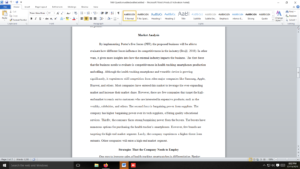Business Proposal
in a 4 to 6 page, APA formatted written paper. It must be a strategy paper, meaning it must be about firms. However, there is a great deal of flexibility in the choice of topic.
Step 1
First, choose an industry, based on interest in the industry. Examples of industries range from advertising to zoos, and include digital watches, private jets, diapers, over-the-counter cold and flu formulas, photographic film, automobiles, airlines, football, romance novels, dating services, banana production, or pre-stressed concrete, computer printers, pagers, business schools, used cars sold over the web, movie theaters.
Step 2
Having chosen the industry, you will need a question or issue on which to focus. Such questions could be broad (What strategies are most likely to sustain profitability?) or narrow (Should firm X build a new plant? Where?). Good questions encourage you to think strategically, and thus should include the likely responses of rival firms to any hypothetical actions. Plan to include your question in the topic proposal. A different approach is to choose a story about the behavior of a firm from a newspaper or other source, and research this story. For example, the defense contractor Lockheed-Martin announced a friendly takeover of Northrop-Grumman, and then later dropped the plan after the Department of Justice filed an antitrust complaint. This story contains a dozen potential paper topics. How is the defense industry organized? Why did they want to merge? Why did the DOJ want to block the merger? Choose a topic in which you are interested rather than one that looks easy. Topics that look easy can be treacherous and unpleasant if they are boring.
Step 3
Develop your written response. An important aspect of business communication is the elimination of the extraneous. Supporting exhibits are not counted in the page total. Using a few well-chosen exhibits is a better strategy than many irrelevant exhibits. It is important to provide references for facts you rely on in the analysis. The paper’s focus should be on analysis, with industry description provided to support that analysis. A common mistake is too much description, too little analysis. Do not choose a situation from a case reading from this or another class. Do not revise a paper you wrote for another course as a project without discussing it with me — it would have to be a new paper to be approved. This project is intended for you to perform hands-on strategic analysis. If you were handed a project to analyze a strategic situation by the CEO of your company, what would you hand back?
IMPORTANT!
When you have collected a great deal of information and begun to rough out your topic, run through this list of tools and ensure that you analyzes the most relevant ones to your topic.
- Five Forces
- Entry barriers, rivalry usually, but not always, the most significant
- Complements
- Differentiation
- Is one dimension enough?
- Cooperation
- Pricing
- Market segmentation
- Rivalry
- First mover advantages and disadvantages
Instructions:
-4 to 6 pages
-Double spacing
-Font: Times New Roman, Size 12
-At least six (6) peer-reviewed sources (include DOI in reference page) (Use them to define terms/concepts)
-No plagiarism
Requirements: 4 to 6 pages
Answer preview
By implementing Porter’s five forces (PFF), the proposed business will be able to evaluate how different forces influence its competitiveness in the industry (Bruijl, 2018). In other wars, it gives more insights into how the external industry impacts the business. The first force that the business needs to evaluate is competitiveness in health tracking smartphones production and selling. Although the health tracking smartphone and wearable device is growing significantly, it experiences stiff competition from other major companies like Samsung, Apple, Huawei, and others. Most companies have entered this market to leverage the ever-expanding market and increase their market share. However, there are few companies that target the high-end market to reach out to customers who are interested in expensive products, such as the wealthy, celebrities, and others. The second force is bargaining power from suppliers.
[1330 Words]

Business Proposal

